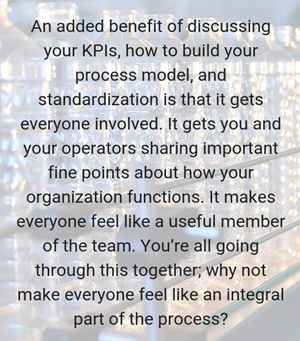In my mind, there are three keys to rapid adoption of your statistical process control (SPC) system:
Operators, Standardization, and Champions.
These are three very important aspects to your SPC system deployment that will help you ensure rapid adoption as well as a solid return on your quality investment. And that’s an important thing we all can agree on. We all want to see that the money we spend for quality and improvement is money well spent.
Operators are Key
So, let me begin with a quick, important note:
Your operators are key to adoption of your quality system. Your operators need to embrace your system, or your hands will be tied. Your deployment will not succeed the way you would like it to.

If you put an SPC system out there for the front-line users, the operators, and they don’t like it (for whatever reason) or it doesn’t make their lives any easier, then you are wasting their time…and your money. They are the primary users, and the tool must work for them. That’s critical. If it meets their approval, they will adopt the system and make it work for them.
The question each operator will ask themselves as they engage with the system is: “
Does this make my job easier and allow me to be more effective than before?”
One way to ensure that they like what you’re giving them is to hand them a product that is easy to use, easy to comprehend, and ultimately enables them to be more effective in identifying issues in real time, thereby driving continuous improvement efforts—which in turn makes them more impactful to the organization
and the bottom line. That’s Enact
®, InfinityQS’ native-cloud quality intelligence platform.
Simplicity Rules
When it comes to software, and perhaps more specifically, its adoption, simplicity is important. Enact has a visually engaging interface. It’s easy to see what’s going on when you just glance at the software. As a user with a pre-defined role, you see only what you need to see. It makes the interface very user-friendly, easy to understand, and easy to navigate.

As my co-worker, Eric Weisbrod, VP of Product Management here at InfinityQS, said in
his recent blog about the
ideal Enact deployment, “pick a specific production line, or family of products, something small that you know needs attention”—in other words, the key KPIs from your factory floor you know you need to focus on.
Getting Started with Your Rapid Adoption
KPIs: Key Performance Indicators. Those data points that show how effectively your company is meeting their business goals. Specifically, what I’d like to talk about is how important they are in terms of rapid adoption of your SPC system.
Every manufacturing enterprise has some KPI (or two, or three) that is really important to them.
So, start with a “handful” of critical key parameters. That’s what we recommend. But it’s really up to the customer what they want to monitor. The bottom line is this: it can be done in a very rapid fashion, especially with our self-help.
Enact Self-Help
Enact provides robust self-service capabilities that help users get the information they need without pulling IT away from other tasks. Context-sensitive Help is currently available in English, German, and Spanish—this invaluable tool directs users to instructions, tips, videos, tutorials, best practices, getting started guides, FAQs, industry examples, and more.

With a self-help system like Enact’s, you can learn at your own pace, dig as deep as you like on topics of your choice, and get all information you want anytime you want it. It comes with the system, and it’s a game-changer.
Enact Process Model
The Enact process model is central to rapid deployment and, hence, adoption. Process models illustrate how materials are transformed through operations to create an end-product and where data collections are performed to verify quality.

These dynamic diagrams are part of the “set-up” of Enact. They show you exactly where and when various materials (represented by inputs) flow into operations to create outputs. You can combine and modify process model elements to create a visual process map, from raw materials all the way to finished goods. With your first process model and data collections in place, you and your managers will start seeing the results immediately. To get into the details of process models and what they can do for you, again, I would suggest reading
Eric’s blog.
Standardization Makes Everything Easier
In addition to keeping your initial deployment simple and using Enact’s robust self-help, another aspect of rapid deployment and adoption is standardization. Since Enact is a cloud-based system, your data is stored in a centralized location. In order for the data to be used enterprise-wide, it must be standardized.
Planning for standardization is important because the deployment (and adoption) goes so much faster and smoother when everything is standardized (as opposed to highly customized).
The four items to consider when planning for standardization are:
- Metrics – Make sure everyone is using the same quality metrics to know what success looks like.
- Analysis methods – Make sure everyone is looking at the data in the same way. Sometimes looking at data using a different method is a result of a legacy practice, or different metrology equipment, etc.
- Naming conventions – When using a centralized system, it’s critical that everyone knows the proper naming conventions, what’s shared, what can be customized, etc.
- Work practices – Ensure that everyone performs the same checks. Often, differences come from an issue you had in the distant past that has been solved, but the “short term” practices put in place to deal with the now non-existent issue have continued “just in case.”
The bottom line is that standardization is not easy.

Everyone representing the various user groups in your organization must agree. But that’s a fight that we promote. It’s worth it…and goes a long way toward rapid adoption and deployment.
Champions of Rapid Deployment and Adoption
Another aspect of rapid adoption is having champions within your company. Folks, preferably at higher levels, that stand behind the decision to use the product, and do most of the heavy lifting during the life of the project.
These key stakeholders really run the show. They know the ins and outs of your organization and can help ensure your project’s success…and how rapidly it occurs. In addition to the higher-level management champions, you also need day-to-day project leads, folks from the factory floor—yes, operators and such—to champion your quality project.

They are the ones promoting your project from the inside to the various business units and departments of your company.
These internal advocates can make the difference between success and failure of your rapid adoption. Another colleague, Rich Osborne, one of our senior account managers, wrote about just such involvement.
His blog is worth a read, too.
Spread the Wealth
A solid, rapid deployment and adoption means the ability to include the entire enterprise. And by enterprise, I mean big, not just one or two plants. When you prove right from the beginning, by picking and monitoring the right KPIs, ensure that your data are standardized, and get those small wins early…well, then you can easily spread across a larger landscape.
Enact is made for scaling. Common scaling strategies include 1)
Reuse: If you manufacture the same products on many production lines at many facilities, a standardized deployment can be shared instantly with those production lines. 2)
Expand a process model to accommodate products (or KPIs) similar to those you piloted. This works well where a large family of products is made in a similar way. 3)
Create similar process models: if your organization offers diverse products, there may be similar operations. And 4)
Upstream/downstream: Effective for products that are either highly problematic (e.g., high defective rate) and/or high value (again, picking the right KPIs to monitor). Creating process models upstream/downstream may be more involved than replicating the first process model, but this may be the fastest route to getting the most value from Enact.

Comparative Analysis Made Easy
So, what is the end result of paying attention to these three key elements of a rapid SPC system deployment and adoption? What does all this do for your organization? Once Enact is adopted, and your users are comfortable with its engaging interface and ease-of-use, and see the value of it, they will embrace it. It will make their lives easier.
And since your data is coming from all your plants and is centralized, you can get a good picture of what each segment of your enterprise is doing, how they’re doing it, and where the issues are. You can look at your data from a big-picture view and assign actual intelligence to improve your processes, your efficiency, and the products that go out the door. That’s the enterprise view. Comparative analysis made easy. This will help drive your business decisions in a very rapid fashion.
Read more about Enact, request a demo, or take a product tour
here.